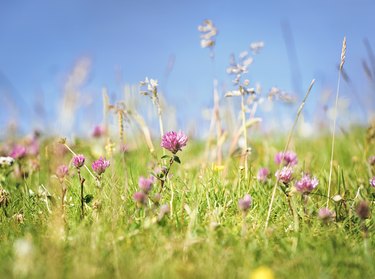
Purple clover (Trifolium purpureum) is an exotic clover species primarily found in U.S. Department of Agriculture zones 5 through 7. The clover is characterized by long, thin leaflets and purple flowers that can grow up to 39 inches tall. Cultivated in some parts of the world as a livestock feed, this self-regenerating plant can overtake your lawn and garden if not kept in check. Getting rid of purple clover may seem like a daunting task, but it may not be as difficult as you think. The trick is making sure you use a method that doesn't kill surrounding grass and flowers as well.
Reasons for Concern
Video of the Day
Although purple clover isn't a noxious weed and benefits the soil by adding nitrogen, a few reasons exist for why you might want to get rid of it. Clover can crowd out existing grass or garden plants, harming flowers and plants or leaving bare spots in the winter when the top growth dies to the ground. The tall purple flowers of the plant can also be unwelcome. Bees and other insects may also be attracted to them, which can cause problems if you spend a lot of time in the yard.
Video of the Day
Mowing may keep the flowers in check in the lawn, but there will still be an obvious disparity between the clover and grass you may simply find unattractive.
Changing the Environment
One option to get rid of purple clover is to change the environment of the yard so grass can thrive but the clover can't. Purple clover does well in moist environments, and clovers, in general, thrive in soil high in phosphorous. Reduce the frequency of your watering routine to dry out the yard or bed where the clover appears, and add nutrients to the soil other than phosphorous that will help grass or plants to grow.
Adding fertilizer high in nitrogen is typically effective at limiting clover's growth while promoting the growth of turfgrass, as long as nitrogen levels don't excessively exceed turf needs. If you know what kind of grass is in your yard, you can find out specifically which nutrients will help it to thrive based on a soil test while you try to starve out the clover.
Manual Removal
If you can catch the purple clover early, you may be able to remove it manually. Clover has a taproot you can dig out with a spade or shovel. This is especially useful when purple clover appears in gardens or flower beds. This may leave a few bare patches where you've had to fill in holes if you do this in the yard, but you can seed these bare spots with grass to create a uniform yard in relatively short order. Keep an eye out for new clover growth in case you didn't get all of the roots, though.
Herbicide Control
If you aren't able to get the clover under control using other methods, a few herbicides exist to clear up clover problems. Choose a selective post-emergence broadleaf herbicide you can apply to kill the clover without harming the surrounding grass. If you use a non-selective herbicide, such as glyphosate, the chemical will kill all plant material it touches.
Herbicides containing mecoprop or dicamba are generally well-tolerated by many turf grasses while still being effective for clover control. Pre-emergence herbicides can be effective but are typically unnecessary if you use other methods.
Apply an herbicide when the clover is still small for maximum effectiveness. Herbicides should be applied using a sprayer held close to the plant to avoid overspray, on a windless day when no rain is expected for 24 to 48 hours. It should be mixed according to package directions, typically 1.5 to 6.5 ounces per gallon of water, depending on the product's concentration.
Always read the label on any herbicide product before using it to ensure it has the specific chemicals you're looking for. It's important to note that some products will kill all vegetation or harm healthy grass while eliminating clover.
Always wear eye and skin protection while using herbicides and avoid breathing in any of the spray while applying it. Contact poison control immediately if you accidentally ingest or breathe in herbicide during mixing or application.